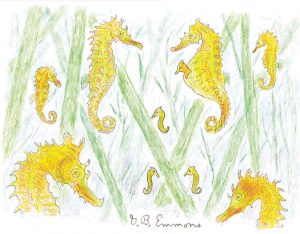There are 54 different species of seahorses in the world. They live along shallow edges of coastlines all over the globe, but they are rarely seen and are often described as the shyest creature on earth.
Seahorses vary in size depending on geographical location and can be found inside fishermen’s shrimp nets, dredged up while eating their favorite food. The smallest pygmy species is as small as your little finger.
Despite its features being visually similar to many other earthly creatures, including the head and neck of a horse and a tail of a kangaroo, the seahorse is classified as fish, having gills to breathe underwater, pectoral fins to navigate, and an internal bladder to swim in a typical upright posture. They also have interlocking body plates like a crustacean crab for protection.
What is called a ‘prehensile’ (adapted to hold or grasp objects) tail is flexible enough to wrap around its neck like a scarf and to even scratch its own head to wonder about how his curious creation ever came to be. Mostly the tail is used to reach out and latch onto a sea grass blade or coral finger to stabilize its location and position in a strong current.
The seahorse’s eyes can move independently, separately moving and focusing in different directions to both objects coming and going like a chameleon. Even more remarkable is the ability, like a chameleon, to change color at the blink of an eye to camouflage itself into the background of its surroundings to hide from predators.
Seahorse reproductive behavior is even more astounding as the male carries the fertilized eggs in a brood pouch placed there by a female. After an elaborate several-day courtship during with couples swim side-by-side holding tails, they both wheel around doing what is called a mystical pre-dawn dance lasting about six minutes. The female then releases her eggs through her ovipositor tube into the male’s brood pouch. He subsequently nourishes them by manufacturing organic compounds as well as hormones for development.
When ready to hatch in a week or two, he convulses his body frame and expels them through a single opening of the pouch. Almost immediately after that, he is ready to receive another brood of eggs from the female to populate throughout the breeding season. This repeated procreation leads to an estimated world population of millions.
Some seahorse populations in the world may be endangered as a result of overfishing, particularly in the Orient for use with Chinese medicine, where seahorse powder is ingested in pills, powders, and syrups to cure kidney disease, impotence, and induce labor. Seahorses are also a favorite delicacy, roasted and sold by street corner vendors impaled on a stick like a lollipop.
This is unfortunate for one of the oldest species on Earth, dating back in fossils 16 million years. This ancient creation came into mankind’s awareness much later, coming to life with Greek mythology and Egyptian art about the time of the Etruscan Empire. It was called hippocampus, (hippo for horse, and campus for sea monster). A favorite myth told how the seahorse steed pulled the aquatic chariot of Poseidon, god and monarch of the sea.
Since then, the seahorse was destined to emerge in the Renaissance movement of great works of art, paintings, woodcuts, carvings, sculpture, and statues. The most world famous is the fountain of Trevi in Rome featuring the winged hippocampus.
There’s one giant seahorse that calls the Town of Mattapoisett its home, known affectionately as Salty the Seahorse. This landmark greets residents every day on their way to work and school, and at night both eyes come alive to light up by solar power. Salty remains under the watchful stewardship of the Mattapoisett Land Trust, and the playground garden park is maintained to honor the generous Dunseith family donation to the town.
Let’s hope Salty continues to reign supreme and stand as a welcoming sentinel for visitors and residents, as well as a mystical silhouette of the real species for children of all ages.
By George B. Emmons
